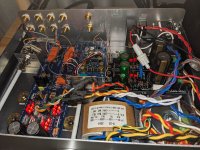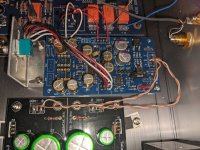Yes I meant when there is no mains earth provision better keep the whole circuit insulated from touch. When you will move house and there is protective earth in the wall sockets, use IEC cable and connect the protective earth prong with thick enough cable to the chassis. Secure it with a bolt and a safety nut.
*Another good reason to insulate your volume knob is it may hum when touched if in continuity with the pot but not grounded.
*Another good reason to insulate your volume knob is it may hum when touched if in continuity with the pot but not grounded.
Many amateurs and good willing laymen do not understand fully what ground and safety earth/ground is and often think they are one and the same as ground is earth right?! It does not help when words like "grounded" and "ungrounded" are used. Therefor the names Audio GND and Protective Earth or PE. PE is for safety and at the primary/mains side of power supplies, Audio GND is at the secondary side of PSUs and it is also the audio circuits common GND. There is not necessarily always a connection between the 2! In a few languages more precise than English the words for primary and secondary ground are different which makes matters more easy to understand.
When PE is available: just connect a metal casing of a DIY device directly to PE (always) according standard procedure. This is for safety and it is mandatory. Except for power amplifiers please do not to connect Audio GND directly to PE as it will cause more issues than it solves. Reference Audio GND to PE by means of one of the "lifting" methods like a 10 Ohm 2W resistor from Audio GND to the central PE point in the device. The connected source/preamp devices with "lifted" Audio GND will have connection to the power amplifiers "non-lifted" Audio GND via their cinch cables but they won't be causing any ground loop. In some areas leaving Audio GND completely floating ( = no connection of Audio GND to PE at all) causes people to look at you like if you have very bad breath but it might be a solution to an issue. "Lifting" Audio GND (or leaving Audio GND floating) avoids the dreaded ground loop.
When PE is available: just connect a metal casing of a DIY device directly to PE (always) according standard procedure. This is for safety and it is mandatory. Except for power amplifiers please do not to connect Audio GND directly to PE as it will cause more issues than it solves. Reference Audio GND to PE by means of one of the "lifting" methods like a 10 Ohm 2W resistor from Audio GND to the central PE point in the device. The connected source/preamp devices with "lifted" Audio GND will have connection to the power amplifiers "non-lifted" Audio GND via their cinch cables but they won't be causing any ground loop. In some areas leaving Audio GND completely floating ( = no connection of Audio GND to PE at all) causes people to look at you like if you have very bad breath but it might be a solution to an issue. "Lifting" Audio GND (or leaving Audio GND floating) avoids the dreaded ground loop.
Last edited:
Nice. Congratulations. I see you skipped op-amps on the Muses board. You skipped the output coupling caps there too. What about the input coupling caps? Can't see for sure what parts are which that far back in the photo. No extra DC offset from the Muses board when skipped parts?
What was your best preferred mechanical pot in DCB1 before trying the Muses electronic "pot"?Thank you Salas.
Finished exchanging carbon pot to muses72323.
I prefer muses volume.
I'm using a pot that cannot be soldered directly to pcb. Whats the correct wiring scheme? For instance for connecting rca sockets with pcb I am using twisted pairs.
Pots have 3 wires per channel. Should I twist all 3 toegether? Should I twist ground and attenuated signal wire cause the signal level is lower than input?
Am I not overthinking this?
Thanks!
Pots have 3 wires per channel. Should I twist all 3 toegether? Should I twist ground and attenuated signal wire cause the signal level is lower than input?
Am I not overthinking this?
Thanks!
If it was quite a sensitive signal level best would be twin core coaxial (microphone cable). For twisted you go three wire braid because the ground wire is common to both send and return signal wires.
Hmm, wouldnt dual core coaxial cause ground loops? As far as I understand there are 2 shields which connected at both ends would form a loop.
Before,I used TKD2508s.What was your best preferred mechanical pot in DCB1 before trying the Muses electronic "pot"?
After listening muses chip long time,I went Vilab 24 step attenuator with dale RN55.
I assumed they have 2 separate shields for both cores.. never knew theres a cable that has 2 cores and a single shield. ThanksTwo twin core coaxial. One for each pot deck's three pins. Or two three wire braids.
Separate cables. Two runs. One per three pins group.
Use thin flexible easy to route. Like with Lavalier mics.

Use thin flexible easy to route. Like with Lavalier mics.
So you went to a mechanical stepped solution rather permanently or still on trial period? Pros & cons of RN55 stepped vs Muses?Before,I used TKD2508s.
After listening muses chip long time,I went Vilab 24 step attenuator with dale RN55.
Muses72323 sound very clear even when small volume and 0.25db volume steps are comfortable.
I liked it for while.
But it sounds a little flat(no 3D like) sound to me so music getting boring after while.
RN55 24 step ladder have more 3D sound but rough steps.Always too loud or less loud.
When small volume, sound get more dull,less tight bass sound.
Probably allo SMD attenuator might be good if they have 20k.
Compare to TKD stepped ladder switch,Vilab is more rough.
I think I might satisfy with TKD or Seiden stepped ladder with dale RN ,audio taper later.
I am trying to build Iron pre with transformer attenuator, and my friend's build balanced iron pre with goldpoint.
I liked it for while.
But it sounds a little flat(no 3D like) sound to me so music getting boring after while.
RN55 24 step ladder have more 3D sound but rough steps.Always too loud or less loud.
When small volume, sound get more dull,less tight bass sound.
Probably allo SMD attenuator might be good if they have 20k.
Compare to TKD stepped ladder switch,Vilab is more rough.
I think I might satisfy with TKD or Seiden stepped ladder with dale RN ,audio taper later.
I am trying to build Iron pre with transformer attenuator, and my friend's build balanced iron pre with goldpoint.
Tamra, you can also use the Mez as a buffer stage and add an AVC after it, removing the resistive pot in front.
nash
nash
- Home
- Amplifiers
- Pass Labs
- Mezmerize DCB1 Building Thread

